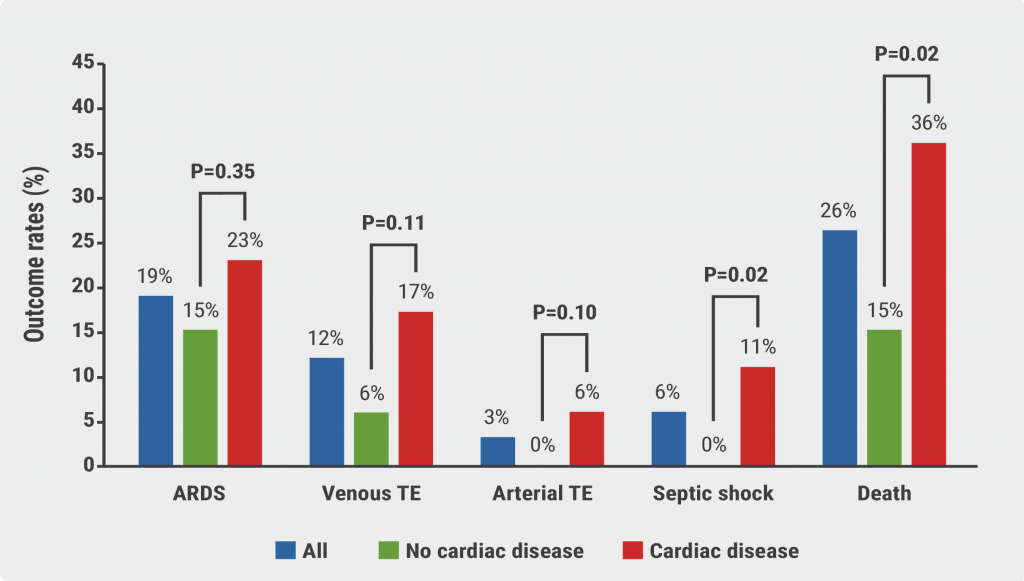In the AFFIRM-AHF study (NCT02937454), treatment with ferric carboxymaltose (FCM) significantly lowered total HF hospitalisations and cardiovascular death. An analysis presented by Prof. Phil McEwan (Swansea University, UK) estimated the cost-effectiveness of FCM compared with placebo for the treatment of iron deficiency in patients with HF from the payer’s perspective in the USA, UK, Italy and Switzerland [1,2]. “These 4 countries were chosen because they have different systems of healthcare,” Prof. McEwan explained. A lifetime Markov model was built to characterise outcomes in patients according to the AFFIRM-AHF trial. In this model, disease status was defined by quartiles in the Kansas City Cardiomyopathy Questionnaire – clinical summary score (KCCQ-CSS), an established tool to assess symptom frequency, physical limitations, social limitations, and quality of life.
FCM treatment in patients admitted for acute HF was estimated to be cost-saving with additional health gains relative to placebo in the USA, UK, and Switzerland and highly cost-effective in Italy. Cost offsets were largely attributable to a reduction in hospitalisations due to HF. Over a lifetime, FCM was associated with an estimated 199 fewer hospitalisations due to HF events per 1,000 patients.
Modest quality-adjusted life years (QALYs) gains of 0.43–0.44 were attributable to increased time in higher KCCQ states. Moreover, sensitivity analyses demonstrated that FCM was cost-effective (i.e. cost per QALY under the current willingness-to-pay threshold) in all subgroups. The greatest cost savings relative to the overall population were seen in patients with a left ventricular ejection fraction of <25%. Patients with a non-ischaemic HF aetiology achieved the greatest increase in QALYs of all the subgroups. FCM also remained dominant or highly cost-effective in patients receiving triple therapy. De novo HF patients had the greatest cost increase per QALY relative to the overall population due to an increase in life expectancy leading to higher HF maintenance costs. This was dominant in the USA and Switzerland, and cost-effective in the UK and Italy.
Prof. McEwan concluded that from a payer’s perspective, “the relative cost offset by avoiding hospitalisation is sufficiently high to justify the acquisition cost of the drug.”
- McEwan P. Ferric carboxymaltose for the treatment of iron deficiency in heart failure: a multinational cost-effectiveness analysis using AFFIRM-AHF. LBT 2, Heart Failure and World Congress on Acute Heart Failure 2021, 29 June–1 July.
- McEwan P, et al. Eur J Heart Fail 2021. Doi 10.1002/ejhf.2270.
Copyright ©2021 Medicom Medical Publishers
Posted on
Previous Article
« Omecamtiv mecarbil might be less effective in patients with atrial fibrillation or flutter Next Article
Novel mineralocorticoid receptor antagonist effective irrespective of HF history »
« Omecamtiv mecarbil might be less effective in patients with atrial fibrillation or flutter Next Article
Novel mineralocorticoid receptor antagonist effective irrespective of HF history »
Table of Contents: HFA 2021
Featured articles
Inconclusive results for dapagliflozin treatment in heart failure
Late-Breaking Trials
Iron substitution improves LVEF in intensively treated CRT patients with iron deficiency
Novel mineralocorticoid receptor antagonist effective irrespective of HF history
Iron substitution in iron-deficient HF patients is highly cost-effective
Omecamtiv mecarbil might be less effective in patients with atrial fibrillation or flutter
Vericiguat effective irrespective of atrial fibrillation status
Baroreflex activation: a novel option to improve heart failure symptoms
Beta-blocker withdrawal to enhance exercise capacity in heart failure?
Inconclusive results for dapagliflozin treatment in heart failure
Computerised cognitive training improves cognitive function in HF patients
COVID-19 and the Heart
COVID-19-related HF: from systemic infection to cardiac inflammation
Myocardial infarction outcomes were significantly affected by the pandemic
TAPSE effective biomarker associated with high-risk of severe COVID-19
COVID-19 in AF patients with HF: no higher mortality but longer hospital stay
Cancer and the Heart
Heart failure patients might be at an increased risk for head and neck cancer
Trastuzumab associated with cardiotoxicity in breast cancer
Heart Failure Prevention and HRQoL in the 21st century
Psychoactive substances put young people at risk of cardiovascular disease
The challenge of improving the quality of life of heart failure patients
SGLT2 Inhibitors in Heart Failure
Empagliflozin linked to lower cardiovascular risk and renal events in real-world study
Efficacy of dapagliflozin and empagliflozin not influenced by diabetes status
Biomarker panel predicts SGLT2 inhibitor response
Best of the Posters
Real-world study suggests sacubitril/valsartan benefits elderly patients with HF
Proenkephalin: A useful biomarker for new-onset heart failure?
Weight loss associated with increased mortality risk in heart failure patients
Echocardiographic parameters linked to dementia diagnosis
© 2024 Medicom Medical Publishers. All rights reserved. Terms and Conditions | Privacy Policy


